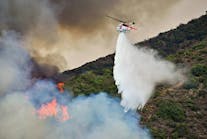Bill for This Year's OR Wildfires Hits $135M
By Damian Mann
Source Mail Tribune, Medford, Ore.
Fires that continue to rage in Southern Oregon this summer have so far racked up a more than $135 million bill, about three-quarters of the dollars spent to battle fires throughout Oregon this season.
Southern Oregon’s remote and rugged wilderness areas have made it particularly difficult to stamp out the 13 major local blazes, adding to the costs and setting the stage for one of the most expensive fire seasons in recent memory.
“There’s a lot of country that doesn’t have any meaningful road systems,” said Brian Ballou, public information officer for the Northwest Interagency Coordination Center, which manages fire operations for 11 state and federal agencies. “It’s a wicked situation to try and put fire lines in.”
In Oregon the estimated cost for wildfire suppression this season stands at $181 million as of Monday with 329,093 acres burned in major blazes, compared to $150 million on the same date in 2017 when 355,122 acres had blackened the state. A major blaze is 100 or more acres in forested areas or 300 or more acres in grasslands.
In Southern Oregon, the most expensive fire so far is the Garner complex, east of Grants Pass, at $41 million. The Garner complex, which formerly included the Taylor Creek fire, is 78 percent contained.
The Taylor Creek fire has roared through 39,804 acres and is 38 percent contained with the bill currently at $12 million.
This fire season is already far ahead of the same date in 2016, when 15 fires burned 123,272 acres in Oregon, costing $48 million.
In 2015 at this time, 28 fires had burned through 157,979 acres, totaling $132 million in costs. Overall, 2015 was the worst recent year for fires with 1.7 million acres burned and a price tag of $609 million.
The money pays for crews, equipment, supplies and expensive aerial support. One retardant drop from a so-called supertanker 747 was reported to cost roughly $250,000 in fighting northern California fires.
When the fire season started two weeks earlier than normal this year, it was difficult to get enough manpower on the lines.
“It was hard to get firefighters to apply and show up for work,” Ballou said. “We’ve had a lot of shortages with the middle management people.”
As a result, 85 firefighters from Australia will soon be out helping with local fires. Firefighters from Oregon have previously gone to Australia to battle that country’s wildfires.
Fires such as the Klondike, burning west of Grants Pass, are particularly difficult to put out because of the lack of existing road systems to develop containment lines, Ballou said.
The Klondike has gobbled up 28,476 acres in the Kalmiopsis Wilderness and is only 5 percent contained. Firefighting costs have totaled $6 million so far.
Ballou said it’s doubtful the Klondike will be contained before the end of summer because of its remote location and the lack of a significant road system to build lines.
“There’s just no way out of this until we get some rain,” he said. “It’s a nightmare to fight fires in there.”
The strategy on the more inaccessible fires is to prevent them from spreading much, particularly toward structures, Ballou said.
After the Garner/Taylor Creek fires, the next biggest fire is the 25,000-acre South Umpqua, burning to the north of Lost Creek Lake. The South Umpqua has cost $25 million to date.
The Sugar Pine fire, burning through 8,885 acres near the South Umpqua, has racked up a $15 million firefighting bill. Both the South Umpqua and the Sugar Pine fires have been renamed to incorporate the primary fires there and the group is now called the Miles/Columbus/Snowshoe/Roundtop fires.
The Natchez, burning on 9,848 acres south of Cave Junction in California along the border, is 30 percent contained at a cost of $14 million.
“We have a lot of fire on the landscape right now,” said Carol Connolly, public information officer for the Northwest Interagency Coordination Center. “It’s critically important that people realize how dry it is out there and we don’t have relief in sight.”
Although no lightning is in the forecast over the next week, Connolly said it’s always a possibility in late summer. That makes it even more important for people to be careful.
“We don’t need human-caused fires as a factor right now,” she said.
Reach reporter Damian Mann at 541-776-4476 or [email protected]. Follow him on www.twitter.com/reporterdm.
———
©2018 the Mail Tribune (Medford, Ore.)
Visit the Mail Tribune (Medford, Ore.) at www.mailtribune.com
Distributed by Tribune Content Agency, LLC.






